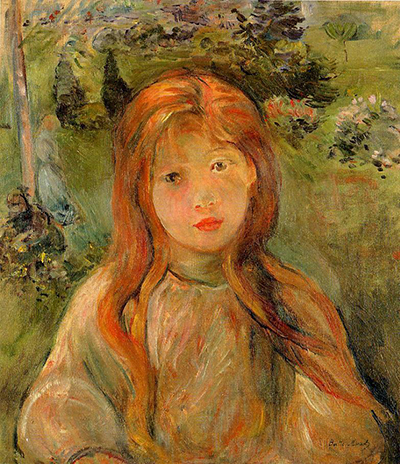This portrait was completed in 1892, by which time its creator, Berthe Morisot, was a fully established artist who had worked alongside other Impressionist painters for a number of years.
This item can be found in a private collection. Light strikes one side of the girl's face, which just makes the eyes slightly different in appearance. This may have been a part of the work that was amended several times, as it doesn't quite work as well as her normal portraits. The model is a young girl with red hair, which hangs down to her chest. She has a sweet appearance and a pale complexion which was particularly popular at the time and symbolises innocence in the eyes of some viewers. The girl is dressed in a simple outfit, and a green landscape is provided behind her right across the background. There appears to be a tall tree on the left hand side, and then darker bushes lining the perspective. Most of this is completed with loose brushstrokes, making it hard to see precise details that might be identified, which is precisely the manner in which the Impressionists worked.
Little Girl at Mesnil remains in a private collection, to the best of our knowledge, and is sized at 42.2 x 47.6 cm. It was completed using oils, which was the artist's main preference, although she did have an extended period in which she focused on watercolours instead. In terms of Mesnil itself, there are several communes within France with this name and so further research would be needed in order to be sure about where this portrait was made. Morisot learnt much from her male colleagues in the Impressionist movement, and in return she provided an important contribution to the group's output, bringing a female intimacy that they could never achieve. They were welcoming to a number of women who had the talent, but were finding it hard to break into a male-dominated industry.
Female portraiture remains the most common genre in which Morisot worked. She truly mastered painting women within their domestic settings, bringing scenes to the attention of the public that had not normally been covered. She also would have inspired other women to move into the art world, seeing what was possible. The early 20th century did show signs of progress with more women appearing but it wasn't really until fairly recently that one might argue that things have approached true fairness. She can be seen as an important contributor in moving towards the situation that we have today.




